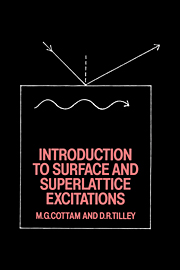Book contents
- Frontmatter
- Contents
- Preface
- 1 Introduction
- 2 Surface waves on elastic media and liquids
- 3 Surface magnons
- 4 Surface magnetostatic modes
- 5 Electronic surface states and dielectric functions
- 6 Surface polaritons
- 7 Layered structures and superlattices
- 8 Concluding remarks
- Appendix Green functions and linear response theory
- References
- Index
6 - Surface polaritons
Published online by Cambridge University Press: 28 October 2009
- Frontmatter
- Contents
- Preface
- 1 Introduction
- 2 Surface waves on elastic media and liquids
- 3 Surface magnons
- 4 Surface magnetostatic modes
- 5 Electronic surface states and dielectric functions
- 6 Surface polaritons
- 7 Layered structures and superlattices
- 8 Concluding remarks
- Appendix Green functions and linear response theory
- References
- Index
Summary
In dealing with magnetic surface modes in Chapters 3 and 4 we found it useful to classify modes, to some extent, by the range of the dominant restoring force. Thus Fig. 4.1 shows that for large enough wavevector |q∥| ≳ 108 m-1, the short-range exchange forces determine the nature of the surface modes. Over a wide range of intermediate wavevectors, approximately 104 m-1 < |q∥| < 107 m-1 the dipole—dipole force is dominant, and the important magnetostatic approximation holds. The properties of the magnetostatic surface modes are found by solving Maxwell's equations without retardation in the presence of the frequency-dependent tensorial magnetic susceptibility χ given by (4.15) to (4.17). Finally, for long-wavelength modes, |q∥| < 103 m-1, retardation cannot be neglected, and it is necessary to solve the full form of Maxwell's equations with susceptibility χ. This is the polariton, or electromagnetic, region, discussion of which has been deferred to this chapter.
Most of this chapter is concerned with electromagnetic, or polariton, modes arising from frequency-dispersion in the dielectric function rather than the magnetic susceptibility. The origin of dispersion was discussed in Chapter 5. Generally it results from the presence of a resonant mode carrying a dipole moment, like the optical phonon in a polar crystal.
Information
- Type
- Chapter
- Information
- Introduction to Surface and Superlattice Excitations , pp. 183 - 246Publisher: Cambridge University PressPrint publication year: 1989
Accessibility standard: Unknown
Why this information is here
This section outlines the accessibility features of this content - including support for screen readers, full keyboard navigation and high-contrast display options. This may not be relevant for you.Accessibility Information
- 2
- Cited by
